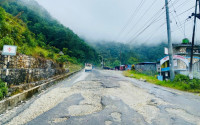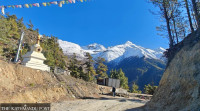Gandaki Province
465 vultures sighted in one place at the same time last week
Conservationists say the incident is first in Nepal in several decades.
Narayan Sharma
In what may be a rare incident, as many as 465 vultures, including some critically endangered species, were sighted in a single place at the same time last week.
Last Wednesday, vultures in such a large number of eight species of the total nine found in Nepal were sighted at a vulture restaurant (an artificial feeding site) in Kawasoti of East Nawalparasi district. The conservationists who are working in vulture conservation are elated upon witnessing such a rare moment.
“This is the first time in several decades that vultures in such a large number have been seen at the same place and same time. It is a good sign of vulture conservation,” said DB Chaudhary, a conservationist who first dreamed of setting up the vulture restaurant in Nepal.
The vulture restaurant was established at Amaltari in East Nawalparasi in 2006. The scavenging birds visited the restaurant to eat carrion. “Two carrions were there at the restaurant that day (Wednesday). The vultures came one after another to scavenge the carrions. Such a huge number of vultures were never seen before,” said Kebal Prasad Chaudhary, an employee at the vulture restaurant.
Nine species of the total 23 vulture species found in the world are recorded in Nepal. Four species—white-rumped vulture, slender-billed vulture, red-headed vulture and Indian vulture—are listed as critically endangered. The Egyptian vulture is listed as endangered and three species—bearded vulture, cinereous vulture and himalayan griffon— are listed as near threatened.
The population of the white-rumped vultures, locally known as dangar gidda, sharply dwindled in South Asia during the 1990s due to diclofenac (DDT) poisoning. Various studies show that the anti-inflammatory drug used to treat livestock found its way into the body of vultures that feed on carcasses and resulted in kidney failure. The poisoning caused by diclofenac emerged as a major cause of death of the endangered species. The country witnessed a sharp decline in vulture populations, especially of the White-rumped Vulture (91 percent) and Slender-billed Vulture (96 percent), between 1995 and 2011.
The government and various organisations, in their efforts to conserve vulture, have launched various conservation programmes. A vulture breeding centre was established in Kasara, Chitwan, in 2008. Vulture ‘restaurants’ were set up in several places where the birds could feed on safe carrions to increase their number. The conservation efforts and the government’s decision to ban the production, sale and use of diclofenac in 2006 helped to increase the population of vultures, mainly of the white-rumped species, in Nepal.
The Chitwan National Park forests and community forests in the buffer zone in East Nawalparasi and Chitwan districts are the major habitats of vultures lately. “Vulture population is gradually increasing in the area due to safe and suitable habitats. The availability of enough Simal (Bombax ceiba) trees in the area serves as a suitable habitat for the vultures,” said DB Chaudhary.
With the increase in vulture population, bird lovers started visiting the Amaltari area. Tourism entrepreneurs are hopeful that the increasing vulture numbers will be helpful in promoting and developing tourism in the area.




 17.12°C Kathmandu
17.12°C Kathmandu.jpg)










